Therapy is no different. According to a recent survey from the American Psychological Association, the majority of therapists in the US switched from in-person to remote therapy during 2020, with many insisting that it works so well that they continue with it even years after society reopened.
Since then, BetterHelp has stood out among the rest. It is considered one of the best online therapy services with a growing network of more than 9,000 licensed professionals, who offer help in almost all areas of mental health. Founded in California in 2013 by two ad-tech professionals, BetterHelp’s goal is to remove some of the challenges related to traditional in-person therapy, including convenience, cost and stigma, and make remote counseling available to anyone, anywhere, anytime.
My Doubts About Online Therapy
But can exclusive remote therapy really be as effective? As someone who has occasionally sought therapy over the course of my adult life, the idea of online therapy was equally exciting and unnerving. The convenience of not having to leave my home for a session was certainly appealing but I had reservations about a lot of things. I was cynical about a Silicon Valley tech firm profiting from people’s mental health problems, and well quite frankly, I just wondered how serious online therapy could really be. Could I find a therapist there who was any good and could offer help beyond the most generic kind of advice? And is it possible to truly connect with someone without any face-to-face interaction at all?
In this review, I will discuss my experience of BetterHelp, what I found using it, and how (despite my initial skepticism) I got more out of it than I could ever have expected.
The Reason I Signed Up
By now you’re probably wondering why I signed up for BetterHelp. It was mainly to write this review, but I also needed help with issues related to anxiety and stress. Like everyone else, the coronavirus pandemic caused havoc in my life: I lost my business, had to start homeschooling my daughter (have you tried teaching a five-year-old how to read? It’s hard!), and consequently decided to simultaneously buy and sell homes to leave the city and start afresh in the country. There was a lot going on and I was struggling to manage my time properly and juggle different balls without losing my mind—and temper—every time there was a slight hiccup.
My usual mechanisms of coping and releasing stress—socializing with friends or going to a sweaty yoga class—were no longer available to me because of the shutdown and I was drinking more and sleeping less, living in a constant state of mental and physical fatigue. I needed help creating structure, changing negative thought patterns, and finding alternative ways of stress relief.
How Does BetterHelp Sign Up Work?
To get set up with a BetterHelp account here’s all you need to do:
- Provide is an email address—you don’t have to give your real name or credentials if you don’t want to.
- Once you’re in, there’s a brief yet pertinent multiple-choice questionnaire to establish your individual needs and preferences for a therapist—whether you’d like a man or a woman, someone gay or straight, or a person who is religious etc.
- Using its algorithm, BetterHelp’s system then matches you with a suitable therapist, a process that for me took about 12 hours.
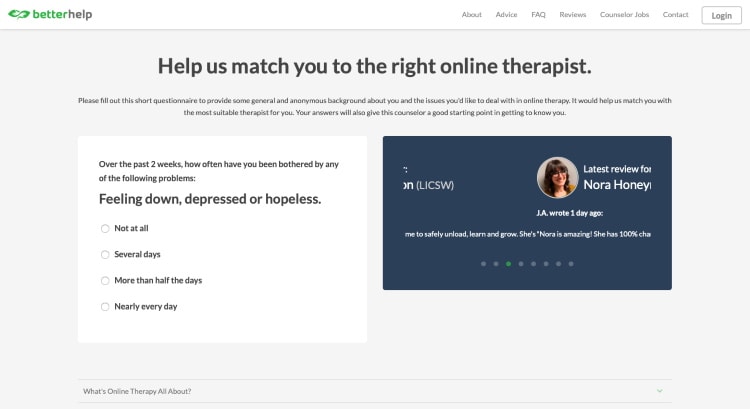
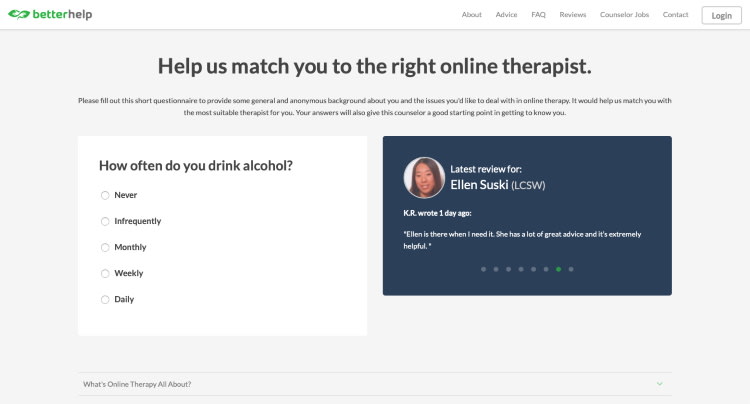
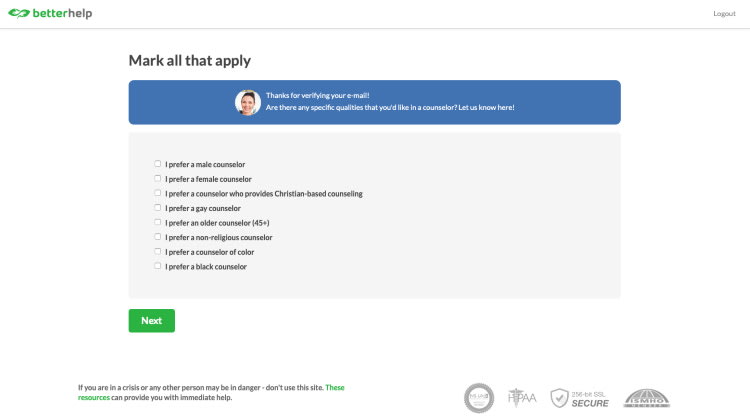
I signed up in the evening and by next morning I had a message from my counselor waiting for me. We made introductions and exchanged a few messages about my therapy requirements and within a day of being connected we had scheduled a phone session (she did not offer video calls) for just a few days later.
Much about this quick start impressed me. I appreciated the swift and easy process to get signed up because, let’s be honest, once you’ve made the decision to seek help the last thing you need is a lengthy and complicated sign-up process to throw you off. What’s more is that it couldn’t have been more different from my experience of finding a therapist the traditional way. About a year ago, it took me nearly two months to find a therapist as nobody in my area was accepting new patients, which had been frustrating to say the least. With BetterHelp I was set up almost instantly. So far so good.
Read the full BetterHelp review
Connecting With My BetterHelp Counselor
My assigned BetterHelp therapist was Jade, a licensed clinical social worker with more than 10 years of experience in providing psychotherapy to people suffering from depression, anxiety, social issues, and self image and low self esteem. Jade had clearly taken the time to read through my profile and understand my needs before making contact.
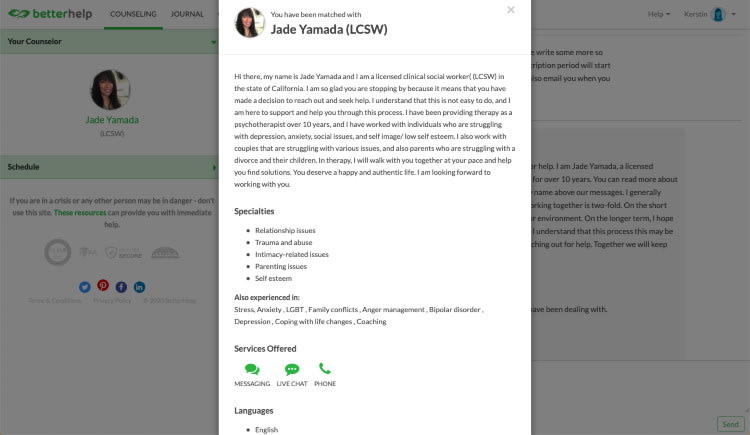
She introduced herself, explaining her background and experience, and she assured me that her goal was to work with me to understand and resolve my issues. “In the short term, I'd like to help you to get some tools that give you [a] sense of control over your environment. In the longer term, I hope that we can get to the bottom of all issues related to your concerns and struggles,” she wrote. She acknowledged that I had “a lot on my plate” and listed each of the issues I had identified in my profile explaining that we would address each individually “one step at a time, in a pace that you feel comfortable with.”
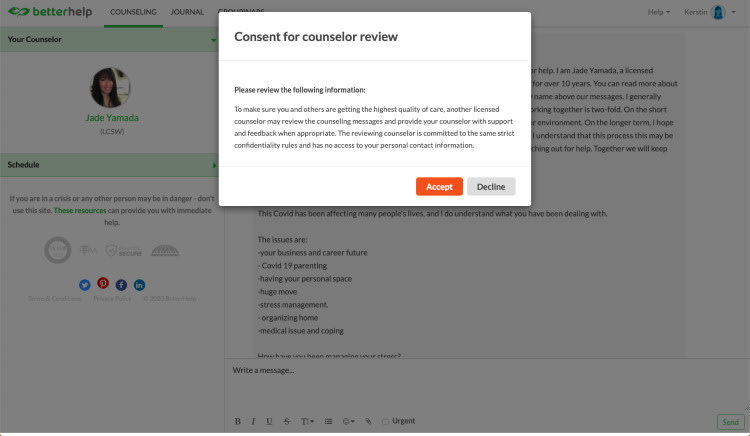
Communicating With My BetterHelp Counselor
All communication with your assigned therapist takes place in a discreet chat room on the BetterHelp app or website. Here you exchange messages, receive worksheets and notes and accept video or audio calls. While you can message your therapist anytime, the response won’t usually be in real-time unless an appointment has been scheduled. That said, you can mark messages as urgent and my therapist Jade reliably responded in a timely manner.
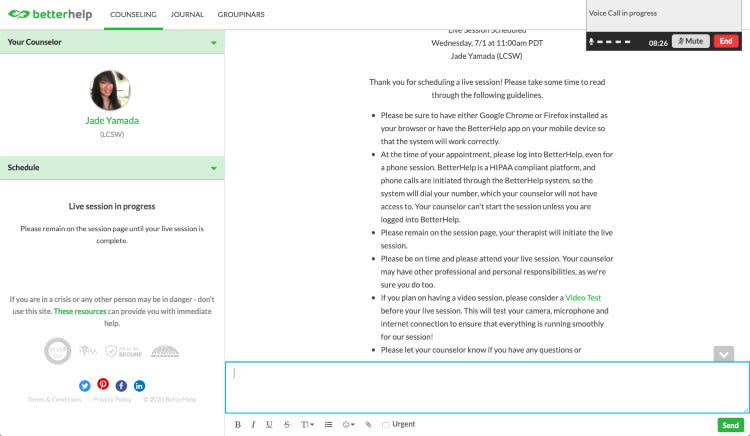
If at any point you need to contact BetterHelp directly, you can do so in the following ways:
To reach BetterHelp’s customer service or provide feedback, visit its “Contact Us” page. You can email the support team at contact@betterhelp.com or submit an inquiry via the website’s contact form. Usually, a BetterHelp consultant replies within a day. You can also leave e-therapy reviews or read testimonials on the website.
You can also write to BetterHelp at the following address:
BetterHelp
990 Villa Street,
Mountain View, CA 94041
BetterHelp Journal
BetterHelp’s platform also includes an online journal, which I found particularly useful. Each day the app will send a “friendly reminder to write in your journal” and to me this was helpful in so many ways, from the therapeutic aspect of writing down my thoughts and emotions to monitoring my progress and discussing my challenges with my therapist during our weekly sessions.
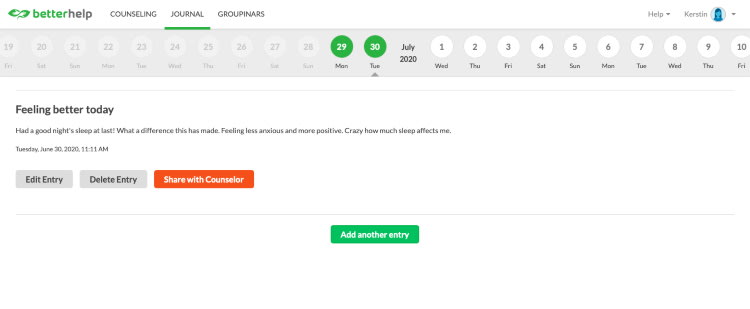
What is an online therapy journal?
An online therapy journal is a digital platform where you can record your thoughts, feelings, and experiences as part of your mental health journey. These journals often support therapeutic techniques and provide a private space for self-reflection. You can document your progress, work through emotions, and track patterns over time, which can be beneficial for both self-guided and professional therapy sessions.
Can your therapist see your journal entries?
You can share your BetterHelp journal entries with your therapist, which can be helpful when working together. Sharing your journal is optional, and I decided not to share mine with the therapist. I decided I wanted to use it more for my own thought gathering process, but there are lots of potential benefits of sharing it with your therapist.
My First Session, And Beyond
When it was time for our first session, I started feeling nervous. My doubts about the legitimacy of BetterHelp resurfaced and I questioned how much I should really open myself up during the session. But when the call came, I instantly warmed to Jade. She was softly spoken, calm, and very sincere, and she immediately made me feel safe.
Throughout our weekly sessions, she listened and consistently acknowledged my difficulties and reassured me that it was absolutely normal for me to feel stressed. She gave me boosts of confidence by complimenting me about my ethos and parenting abilities and a breakthrough for me came when she identified what I had been labeling as anxiety and depression as mental exhaustion. My mind was simply overloaded due to the enormous amount of challenges I was facing and as a result I was fatigued and struggling to cope. It made complete sense and took a huge weight off realizing that my struggles were circumstantial and that by working through them I could feel better.
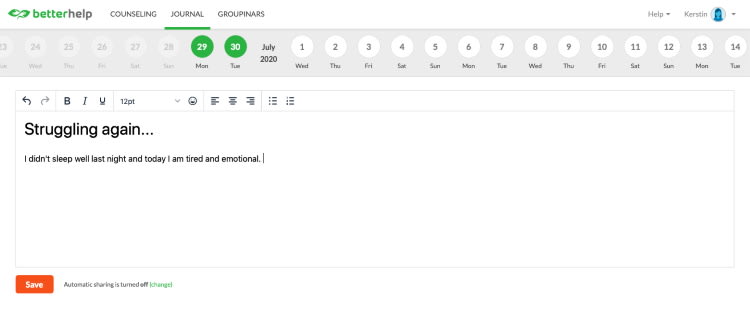
Learning to Breathe, Virtually
Jade helped me to understand my feelings of negativity and stress and where they were coming from, and slowly but surely she equipped me with different tools to combat them. We worked on breathing and progressive muscle relaxation techniques to help me calm and sleep better at night; we worked on ways of breaking automatic negative thought patterns to prevent my mind from catastrophizing each time there was a challenge; and she sent me a schedule template she had designed to help me structure my days and manage my time more effectively.
Jade never overwhelmed me with her suggestions but always made sure that I was ready and willing to receive them and her notes were short and to the point, both easy and quick to digest. All through our sessions, I never once felt rushed and she never put a timer on our calls, which sometimes were as quick as 25 minutes and other times lasted for over an hour—all depending on how much time I needed.
Overall, I Had a Very Positive Experience With BetterHelp
After a month of journaling, speaking with Jade each week, and working through the various sheets she had sent, I had made tremendous progress. My sleep had improved dramatically and I was no longer living in a state of constant exhaustion; I was able to recognize negative thoughts and—at times, not always—divert them into positive ones using the process Jade had taught me; and I finally had a daily structure to work with that helped me not just manage my time better, but at the end of each day, have a sense of achievement rather than failure.
My doubts about BetterHelp had been real, but I was sincerely surprised to find that, as an alternative to in-person therapy, it indeed offers better help. From the moment I signed up, I felt like I was in good hands. The ease of being paired with a therapist was also a huge relief. But most importantly, I found a therapist whom I not just connected with, but who really took the time to understand and get to know me on a deeper level—who listened, never rushed our sessions, and who really, truly helped me. This year may have forced us to rethink the way we do things, but at least some positives have come out of it.
